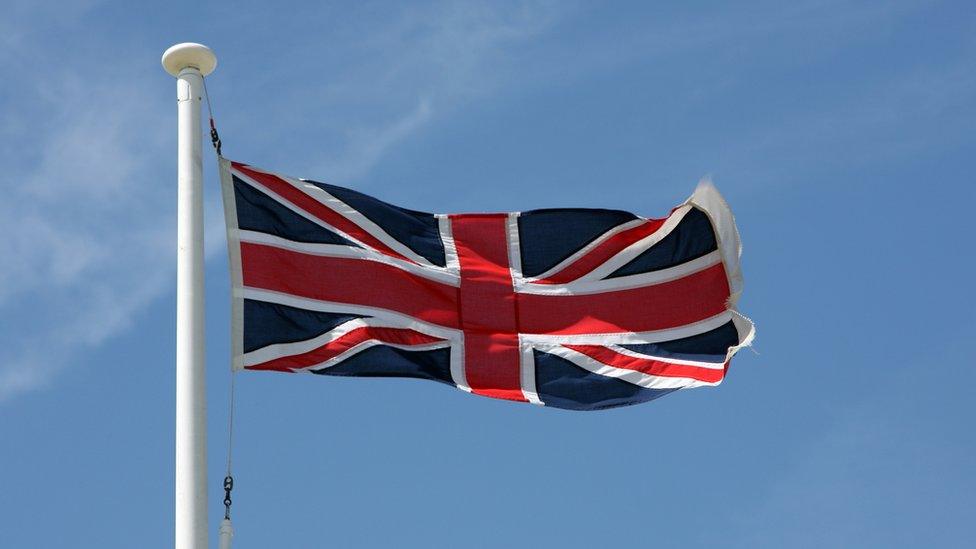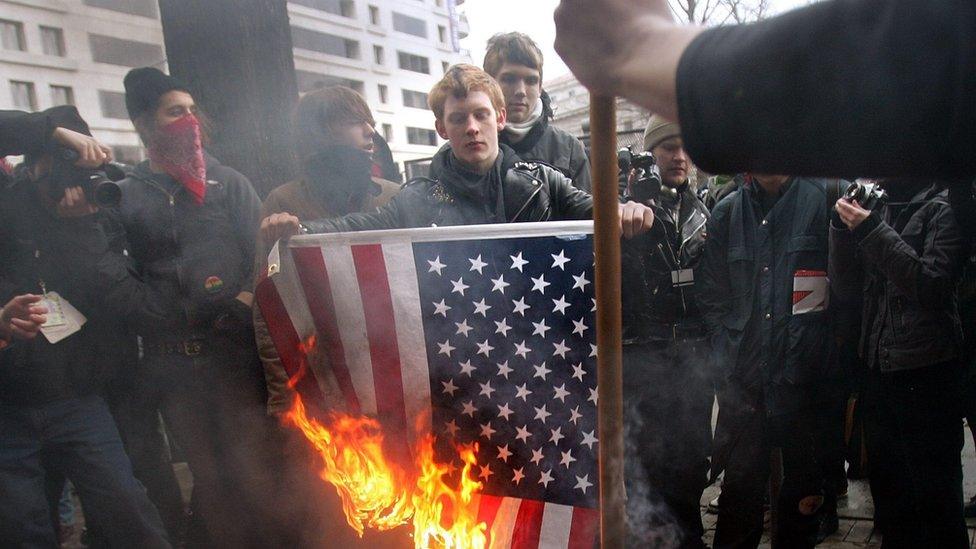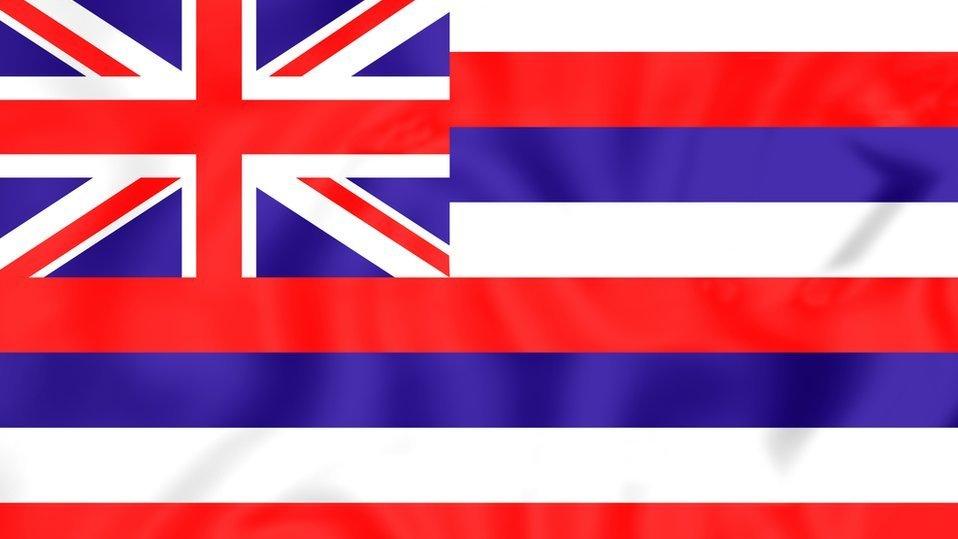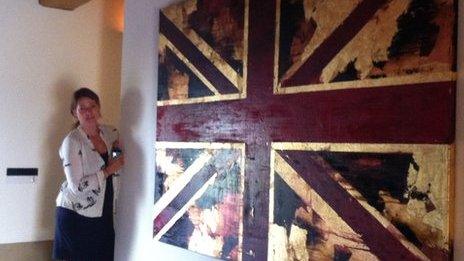Is it possible to disrespect the flag?
- Published

What happens when the colours of the flag are changed?
Earlier this month, the centre of Belfast was awash with colour for the annual Pride celebration.
Among the wide assortment of designs using the rainbow colours, one used by the Ulster Unionist Party (UUP) featured the union flag.
The banner, which included a Pride in the union message, was held up by party members, including MLAs Doug Beattie and Mike Nesbitt, and former MP Danny Kinahan.
Allow X content?
This article contains content provided by X. We ask for your permission before anything is loaded, as they may be using cookies and other technologies. You may want to read X’s cookie policy, external and privacy policy, external before accepting. To view this content choose ‘accept and continue’.

The image drew the ire of TUV leader Jim Allister, who responded on Twitter by calling it a "shameful perversion of the union flag".
In a follow-up statement, Mr Allister called the redesign an "emasculation".
"By overlaying, or infecting, the union flag with LGBT's rainbow colours, great disrespect was shown to our national flag in an attempt to misuse it in support of LGBT demands," he said.
So just what can you do with the flag?
"Well, the thing is, it is not the union flag," explains Graham Bartram, chief vexillologist with the Flag Institute. Vexillology is the study of flags and related emblems.
Mr Bartram has designed numerous flags, including the flag of the Supreme Court of the United Kingdom, and the flag for Tristan da Cunha, part of a British Overseas Territory also including Saint Helena and the Ascension Island.
"It would be a bit like a Frenchman saying the Irish flag was an abuse of the French flag. They are not the same flag anymore because they are different colours," he said.

The Irish tricolour takes its inspiration from the French flag, and came into common usage around the time of the French Revolution in the middle of the 19th century
"If Ireland had gone for a French flag with a shamrock in the middle, a Frenchman might have something to say about it."
The United Kingdom, Mr Bartram explains, is in the unusual position of having a flag which can be identified by its shape.
"Therefore, people think, if you change the colours you can still tell it is supposed to be a British flag, but it isn't."
Official rules on the flag
'Flying Flags in the United Kingdom', external, an official document produced by the parliamentary Flags and Heraldry Committee, lays down the guidelines for flag protocol in the United Kingdom.
It covers a range of particulars, from flagpole positioning, placement on a speaker's platform, to use as a pall on a coffin.
"There are no laws on flags in the UK though. Not on land anyway," said Mr Bartram.
This was confirmed by a spokeswoman for the Department for Digital, Culture, Media and Sport, which is responsible for setting designated days for flying the union flag on government buildings, who said there was "no legislation governing flag flying in the United Kingdom".
At sea, things are a bit different.
The Merchant Shipping Act, external lays out rules around what type of British ensign - an adaption of the Union flag designed for use on a boat - can be flown.
It is possible to make an official application to carry out what is known as a defacement of the flag - where additional material is placed on top of the original design.
A spokesman for the Royal Navy said the rules in the area were "very complicated", but where an application was being made to deface the flag, it would be signed off on by the secretary of state for Defence, acting on advice from the Royal Navy.
There would also be possible involvement from one of the Royal Navy's most senior admirals, the Second Sea Lord.
The Royal Navy spokesman added the British White ensign, which is only used on UK warships, "cannot be defaced because it's a symbol of the legal status of a vessel as a warship".
Rules in Northern Ireland
Interestingly, but perhaps unsurprisingly, Northern Ireland has some of its own rules which apply to the flying of flags, although these are also more guidance than law.
Each summer flags are erected on lampposts, which are supposed to follow the joint protocol on the display of flags in public areas, external, published by the Executive Office in 2005.
The document describes flags in Northern Ireland as "an emotive issue".
It notes that it is clear that the flying of flags "supporting proscribed organisations" is illegal, but that "what can be less clear is what constitutes such a flag, in the eyes of the law".
It also highlights the fact that there are multiple stakeholders involved in the issue, and emphasises the need for community engagement.
In the past, the PSNI has said the erection of flags is not a police responsibility, and it will only act to remove the flags where there is a substantial risk to public safety.
Only when offence is intended
"One of the rules of the protocol in the kind of work I do is that it is only really offensive to the flag when offence is intended," Mr Bartram said.
"If by doing it in Pride colours they have not intended to insult the flag, they are doing it to show that unionism and LGBT can go together, then they haven't created offence.

Although frowned upon, burning the flag in the United States is not illegal
"For instance, in America burning flags is very bad, if you burn an American flag, people get very upset.
"But what do you do with old American flags?
"You burn old American flags. The difference is you burn them with reverence."
- Published24 March 2016

- Published6 December 2013
